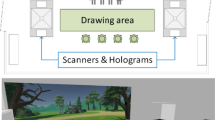Abstract
This paper describes an interactive device, the Periscope, designed to be used as an educational tool featured during a children's digitally enhanced field trip in a woodland setting. The Periscope assembly, including a display and RFID equipped tangibles, is controlled using handles that enable it to be raised and rotated. The display is controlled by rotating the Periscope, or alternatively by twisting the handles. A set of tangibles, a collection of Petri dishes fitted with RFID tags, enable the children to carry out experiments with the results being shown on the display. Field trials are also outlined in which the effectiveness of this design is established. In conclusion, we discuss the aesthetic design issues raised by introducing digital technology into everyday environments.
Similar content being viewed by others
Explore related subjects
Discover the latest articles and news from researchers in related subjects, suggested using machine learning.Acknowledgments.
Special thanks to Sara Price of the School of Cognitive Sciences (COGS), University of Sussex; Ted Phelps (COGS/Distributed Systems Technology Centre, Brisbane, Australia); and to the Intelligence, Agents, Multimedia Group (IAM) at the University of Southampton. Technical support at the University of Sussex was provided by Keith Nie (Mechanical Engineering), Richard White and Barry Jackson (COGS/Electrical Engineering), Timothy Summers and Wally Barnet (BIOLS/Plastics). Flash animations and Spider-in-Stasis by Mia Underwood (COGS). All QuickTimes used in the Ambient Wood Project were sourced from the BBC Film Library in Bristol. Funding for this work is received from the U.K. Engineering and Physical Sciences Research Council, Grant No. 15986 as part of the Equator IRC.
Author information
Authors and Affiliations
Corresponding author
Rights and permissions
About this article
Cite this article
Wilde, D., Harris, E., Rogers, Y. et al. The Periscope: supporting a computer enhanced field trip for children. Pers Ubiquit Comput 7, 227–233 (2003). https://doi.org/10.1007/s00779-003-0230-2
Received:
Accepted:
Issue Date:
DOI: https://doi.org/10.1007/s00779-003-0230-2




